Do-it-yourself refilling of gas cylinders for burners: instructions for different types of cylinders
However, small volumes of gas in cylinders force the user to often buy new ones or think about refilling them themselves. We will tell you how to refill gas cartridges for burners with your own hands. This simple procedure will help save your money.
Our proposed article discusses all refueling options available for independent implementation. Detailed instructions and recommendations for performing the work are provided. Taking into account our tips, you can easily cope with filling a mini container with liquefied gas.
The content of the article:
Types of cartridges for tourist burners
Hikers and hikers need a source of fire for cooking. In such cases, gas burners are a convenient tool. They also find active use in construction and households.
Users who decide to refill gas canisters themselves in order to save money must follow safety rules, take into account the nuances and follow the replacement technology. Then this procedure will go smoothly and without unwanted consequences.

First you need to determine the type of connection of the cylinder to the burner.
There are four types of connection:
- Threaded EU — designed for fixing the burner by screwing it onto a cylinder, meets European standards;
- Threaded US - similar to the first type of connection with a slight difference, meets American standards;
- collet — the burner is pressed on and rotated a little until it locks, there is a safety valve, you can buy an adapter, with prolonged use the mount becomes loose and a gas leak is possible;
- Valve — secured with a special clamp, such cylinders are attached only to burner models intended for them, the valve prevents gas leakage, and in practice has the longest service life;
- Pierceable — a disposable cylinder is attached with light pressure and is not removed until the gas is completely used up; it cannot be refilled.
The most common type of replacement cartridge for work gas burner equipped with thread. It is simpler and more convenient for regular replacement.
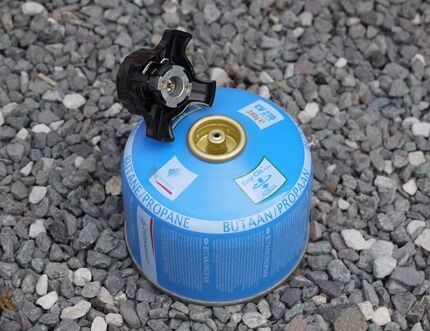
You can disconnect a threaded can at any time, but with a pierceable type this will not work. We'll have to wait until it's empty.
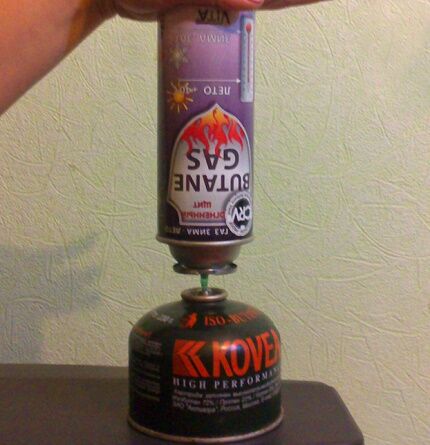
Refilling cans with threaded connection
The first step before refueling is to find a gas source. Large ones are used as a source. gas cylinders various volumes from five to three hundred liters.You need to make sure that your canister does not contain any gas residue and empty it completely.
Next, you need to find an adapter suitable for mounting the gas source cylinder and mounting the empty cylinder. The adapter can be purchased or assembled with your own hands.
It is important that it does not allow gas leakage during transfusion. You also need to find accurate scales that will allow you to weigh the empty can before and after refilling in order to find out the weight of the filled gas.
Now we will describe how to refill a gas cartridge step by step from a large cylinder without buying a new one:
- We weigh the empty can and determine its exact weight;
- We place the large cylinder horizontally and fix it in any suitable way. You should put something under the bottom of the cylinder so that it is higher than the top. This trick will make it easier to transfer gas;
- Using a pre-prepared adapter, connect the empty canister to the gas source;
- We close the adapter valve on the canister, and unscrew the valve of the large canister;
- Slowly unscrew valve on the cylinder and start refueling;
- While you can hear the gas moving through the hose, refueling occurs; if the sound disappears, you can shake the can. This will allow you to add a little more gas;
- After the sound of transfusion has completely disappeared, you should close both valves, unscrew the can, and shake it. If a sound is heard floundering filled with liquefied fuel, then refueling was successful;
- You should also check the tightness of the can using a soap solution;
- Then we weigh the filled canister and determine the weight of the gas inside it. If there is more gas than necessary, then you need to bleed off the excess.
Typically, 10 minutes is enough to refill a mini-cylinder.This period of time allows you to fill in approximately 150 - 180 grams of liquefied blue fuel.
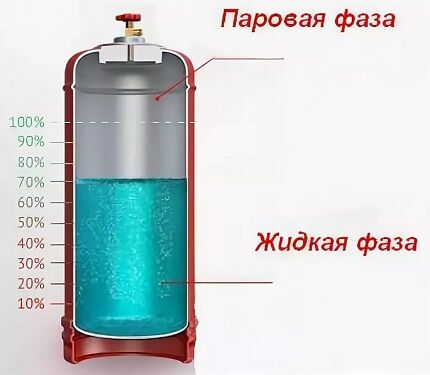
Refilling cartridges with collet connection
To refill cans with a collet connection, it is worth purchasing an adapter or adapter designed for this purpose. Its cost in online stores usually does not exceed ten dollars.
The design of this device is as follows: a tube made of polymer or metal alloy is equipped with a union nut on one side. It provides a sealed attachment to a large gas cylinder, and on the other side there is a collet clamp with a handle that opens or closes the flow of gas into the cylinder.
So, to refuel small gas cylinders with a collet mount from a large one, a series of actions should be carried out sequentially:
- Weigh the empty can;
- Close the valve in the collet clamp on the adapter;
- We screw the union nut to the gas source (this can be a cylinder of any volume);
- We check the tightness of the adapter connection with a soap solution;
- We turn the large cylinder upside down, since we are interested in liquid gas;
- We attach the collet clamp to an empty tourist can;
- Using the handle, we release the gas, which will fill the container for some time;
- We close the valve, unscrew the can, check its tightness and weigh it. It indicates how much a full can should weigh, this is an approximate guideline.
Remember that when storing a travel spray can, mini burners in hot rooms at high temperatures, the gas inside it expands. If you do not leave a gas cap, a kind of reserve of volume in the can, then it may swell. That is, it is necessary to fill the can so that you can hear floundering liquid gas inside.
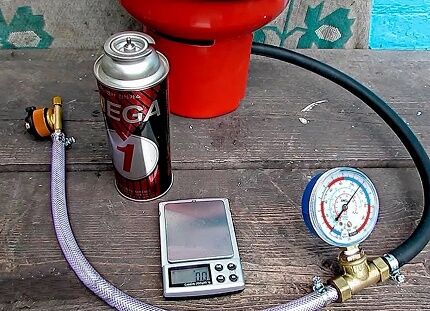
During transfusion, the filling system cools down and even becomes covered with frost. Don't be afraid, just wait until everything thaws and continue working.
It is recommended to work exclusively with gloves. Always screw in the adapter carefully, as it is very easy to damage the thread, which will make further refilling of the travel gas cylinder at home impossible.
In the room where gas transfusion is carried out, there should be no sources of fire, operating pipe soldering torches or a switched-on burner. Some cans cannot be refilled. For safety reasons, it is recommended to refill one can no more than four times and then buy a new one.
Many manufacturers point out that it is inadmissible to refuel their products. Cylinders from well-known manufacturers tend to last longer. If dents appear on the body and other signs of deformation, you should not take risks, but rather throw away such a can and buy a new one.

Refilling valve thread cartridges
Refilling valve threaded cartridges requires the following pre-prepared equipment:
- Two fittings: one, with a union nut, is connected to a household gas cylinder, and the second, threaded, is connected to a gas cartridge;
- A transparent hose with which you can monitor the process of gas transfusion. Also serves as an adapter and connects to two fittings;
- Valves that allow you to turn on and off the gas supply from the cylinder right at the valve;
- A filter built into the valve that prevents debris from entering and clogging the can;
- An additional valve that allows you to bleed gas without removing the adapter.
A good adapter model outperforms a cheap one due to a number of advantages:
- The adapter valve ensures the safety of the valve of a household cylinder, which deteriorates due to regular unscrewing and tightening and due to rust or other metal particles falling on the threads;
- Due to the fact that the valve is in the closest position to the canister valve, during the next filling cycle there is practically no leakage of excess gas, pouring it onto your hands and spraying it into the environment;
- The ball valve design allows you to quickly stop the gas supply and avoid unwanted overflow and forced release of excess gas;
- Thanks to the advantages described above, the refueling process is noticeably easier, safer and more economical.
The adapter is screwed onto the valve of a large household gas cylinder instead of the reducer. It is better to do refueling in the company of an assistant and in the open air away from crowded places. Since there will be a strong smell of gas, people passing by may become worried and call the gas service.
The process of refilling valve threaded cartridges consists of the following steps:
Step 1. First of all, you should drain the remaining condensate, release the residual pressure in all cylinders that you plan to refill before the adapter is connected to the large cylinder. This will make the refueling process a little faster.
The adapter is screwed onto the canister, which is turned upside down; with warm hands, the cartridge is slightly heated, which increases the volume of gas and speeds up the bleeding process. It is preferable to drain the condensate into a plastic bottle. It smells quite unpleasant and permeates the surrounding objects with the smell.
Step 2. Preparing the system involves placing the gas cylinder in a stable position with the valve pointing downwards and opening free access to it. Under no circumstances should the cylinder rest against the valve. The ideal option is to hang the cylinder upside down. Next, tighten the adapter and open the valve of the large cylinder.
Step 3. The adapter is tightly screwed to the can. Open the valve on the adapter and begin to fill in gas. The cessation of the noise made by the gas pouring means the end of the filling.
Step 4. The next step is to release the gas in order to cool the canister. The procedure is performed by opening the bleed valve on the adapter. After a few seconds, the can will become cold enough and the pressure in it will drop to the desired level. Close the valve. If necessary, it is carried out refilling.
Step 5. The most important step is to create a buffer cushion in the can to prevent possible expansion and explosion. Open the bleed valve and wait for the moment when the liquid no longer flows.
Never point the gas stream at yourself.When shaking the can you should definitely feel floundering. Another effective method is to weigh the filled canister on a scale. After going through all the steps, it is important to check the tightness of all filled containers.

For safety reasons, it is not recommended to store cans in the sun, in damp or cold places. Cold cylinders after filling are covered with a layer of condensate. To prevent rusting processes, it is worth wiping the containers with a dry towel.
Transferring gas from one canister to another
After using gas burners, cartridges with gas residues often remain. They should not be thrown away, as there is a possibility of gas transfer from one cylinder to another. Collet cartridges cost about half as much as threaded cartridges, have the same volume and are more common on the market.
Burners can be designed for both collet and threaded mounting, and some models initially have adapters. Refilling a threaded cartridge with a collet will save a fair amount of money, and collet cartridges are also easier to find.
Sometimes an adapter does not turn out to be a solution to the problem, since it weighs a lot and takes up space. In such cases, it is enough to simply transfer gas from one cylinder to another using simple technology and the use of an adapter made with your own hands from a disposable syringe.
Stages of preparing a homemade adapter:
- Using pliers you need to pull the needle out of the plastic. After this procedure, a hole remains, which needs to be slightly expanded using a small drill or a round awl heated over a fire.
- Next, use a knife or file to cut or erase the plastic ribs on the conical part.
- The end of the product from which the needle was previously protruded is cut off obliquely. Thanks to this, the valve will not shut off the gas supply.
- We cut the product from below with a knife by about three millimeters, thereby shortening it.
After preparing the adapter, the threaded cartridge should be cooled and the collet cartridge should be heated. This will make the gas transfusion much easier. You can cool it in the refrigerator or freezer and heat it in warm water. Do not place cylinders near fire under any circumstances.

Transfusion stages:
- When the cylinders have cooled and warmed up to a sufficient level (about 10-15 minutes), take a collet cylinder and attach an adapter made from a needle onto it.
- Then we turn the collet cartridge upside down, and press the tip of the needle product into the hole of the threaded cartridge. After this, you should press the collet can. You will hear the gas flowing.
- When the procedure is over, you can re-cool the threaded and warm up the collet cylinders and refill the gas. Repeat until further heating and cooling bring results.
The transfusion process takes a fairly long period of time and requires increased pressure on the collet bottle, which can cause some discomfort. To eliminate discomfort, you can use a towel folded several times.
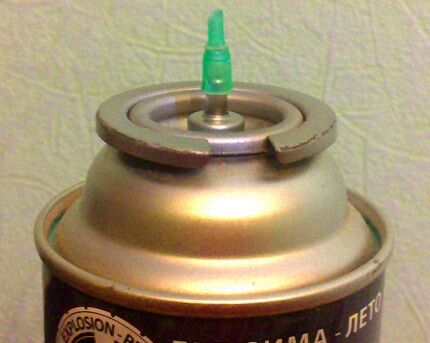
If you have the financial opportunity, you can purchase a special adapter rather than making it yourself. In this case, the gas transfusion process will be significantly simplified.
Conclusions and useful video on the topic
The video will clearly demonstrate the procedure for filling a canister with pouring liquefied gas from a large cylinder:
Refilling travel gas cans is a feasible procedure at home. To successfully transfer gas, you need to monitor the implementation of each stage and follow safety regulations.
After several refills, the procedure is remembered and becomes less complicated. Remember that manufacturers do not recommend refilling and using cartridges for camping burners after they run out of gas.
Would you like to talk about your own experience gained while filling a gas canister with liquefied gas from a large one? Do you have useful information on the topic of the article that is worth sharing with site visitors? Please write comments, ask questions and post photos in the block below.




How safe is it to refill gas cylinders for a camping burner? I am especially interested in the safety of transferring from one not fully used cylinder to another. Still, cooling and heating are not the safest manipulations when it comes to gas.
And the second question: how many refilling cycles will a regular store-bought cylinder withstand?
In principle, the answers to your questions are already contained in the article, but if it is difficult for you to read it completely or at least diagonally, then I will still answer you, maybe it will be useful to others. Firstly, it didn’t hurt to indicate what type of cylinder you are interested in, what kind of tourist option you are using. Secondly, cylinders have different types of connections, depending on which you get one or another degree of complexity and risk when refilling. Look at what type of connection you have and read the operating and safety rules for refueling specifically for it.
As for the number of refilling cycles, you don’t have to worry about the safety of the cylinder for three years.
And one more small nuance: the volume of automobile propane (winter), the proportion of 25% butane and 75% propane occupies 108% of the volume of the liquid phase of gas in liquid form. When refueling, keep this point in mind! And I hope there is no need to explain why all these procedures need to be carried out outdoors!